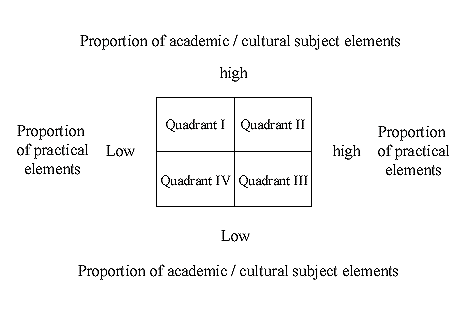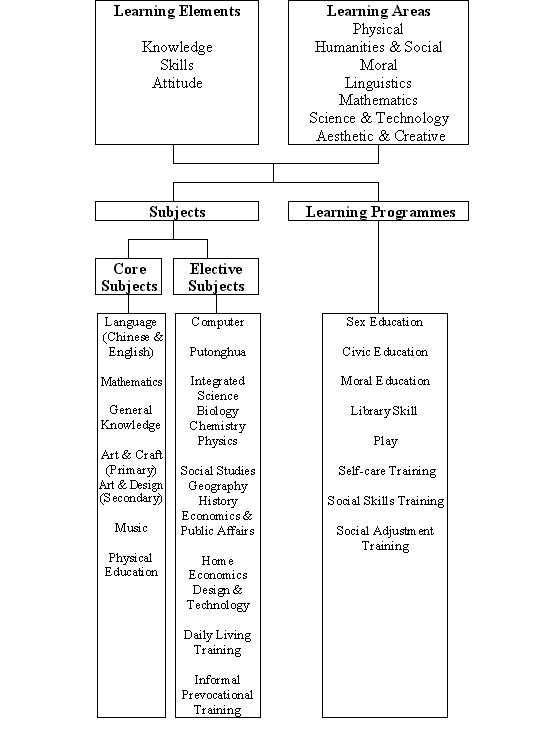Some pupils of schools for the physically handicapped, though with physical disabilities, can learn the mainstream curriculum without special problems as their learning abilities are not affected. However, over half of the pupils are affected by various degrees of mental or perceptual-motor limitations besides difficulties in movements. So when planning curriculum and implementation strategies we should take into consideration their individual differences in abilities in movement, communication, daily living skills, social competency, studies and career development after leaving school. At the same time, with the goal of integration, the curriculum for these special schools cannot depart completely from the mainstream curriculum. To meet these requirements, some principles for consideration when designing the curriculum are suggested below:
Be pupil oriented. The learning content should match with the characteristics of individual pupils (age, mental and physical abilities).
Emphasis is placed on the total and balanced development of pupils. The curriculum should be made up of academic, cultural and practical subjects. Elements related to basic skills, daily living skills and preparation for school leaving should be stressed. Moreover, learning areas should be inter-related rather than compartmentalized.
Every segment of school life is part of the curriculum. School routine should be carefully planned so that pupils can learn and practise any time in school.
The curriculum should prepare pupils to integrate in ordinary environment regarding daily living, schooling and future employment.
Since every special school has its unique background, mission, admission criteria, environment, equipment, etc., so curriculum development, besides following a general direction, should be school-based.
Since the curriculum should concern the development of all aspects of the pupils, consorted effort of teachers, therapists and other disciplines is needed in designing the curriculum content.
Based on the above listed principles, the general direction of the curriculum for physically handicapped children is to take care of individual needs and at the same time keep it in line with the mainstream curriculum.
Under this premise, the learning areas (
Physical,Humanitiesand Social,Moral,Below is a diagram describing the need of subject elements in the curriculum of different groups of pupils in schools for the physically handicapped.
(Diagram adapted from "The Application of the Conductive Education System" by the Spastics Association of Hong Kong)

The above diagram is explained as follows:
1. The vertical axis represents the amount of academic / cultural subjects or knowledge and skills from academic / cultural subjects 2. The horizontal axis stands for the amount of practical subjects or practical knowledge and skills from other subjects 3. The four curriculum quadrants demarcated by the vertical and horizontal axis are :
The curriculum for Quadrant I is made up of higher proportion of academic subject elements but lower proportion of practical subject elements
The curriculum of Quadrant II is made up of equally high proportion of academic and practical subject elements
The curriculum of Quadrant III is made up of lower proportion of academic subject elements but higher proportion of practical subject elements
The curriculum of Quadrant IV is made up of equally low proportion of academic and practical subject elements
4. The proportion of need in academic and practical subject elements is decided by the characteristics of the pupils 5. In a school for physically handicapped children, there are more pupils requiring the first and third quadrants of subject element combinations. Seldom any pupils need the subject element combinations of the second quadrant and there may not be any need for the conditions shown in the fourth quadrant.
Based on the rationale mentioned in paragraph 4.3, the learning areas and general direction of mainstream curriculum are also suitable for children in schools for physically handicapped children but adjustment according to pupils' needs are required. Generally speaking, pupils first admitted into schools for the physically handicapped may not have developed the basic skills like ordinary pupils first joining mainstream schools. To enhance the effect of learning and personal development of pupils, schools should add in or strengthen the teaching of the following basic skills :perceptual motor,basic language,For this reason, schools for the physically handicapped should enhance the development of the above mentioned skills in the Physical, Humanities and Social, Moral, Linguistics, Mathematics, Science and Technology, Aesthetics and Creative aspects of learning.
For pupils to acquire knowledge, skills and positive learning attitudes in the various learning areas, suitable academic, cultural and practical subjects must be taught. As for thecross subject content or issues geared to the specific needs of physically handicapped children, they are not necessarily taught as independent subjects but can be diffused into the already existing subjects as special activities or integrated activities of the school routine.The quadrants presented in paragraph 4.3 have expressed the needs of different groups of pupils. Nevertheless, to give pupils a comprehensive education, schools should teach their pupils the above mentioned seven learning areas so that they can learn as much knowledge, skills and good attitudes as they can. So the curriculum for their pupils should contain core subjects for every pupil, elective subjects for pupils of different abilities and issue-based learning programmes specially designed to cover areas not included in the existing subjects. At the same time, teachers should pay attention to the ability of individual pupils in different subjects so that the subject content for each of them may be selected, modified, tailored or re-grouped accordingly.
Below is a suggested table of curriculum framework and content for special schools for the physically handicapped.

In this curriculum framework, core subjects are taken by all pupils to acquire the necessary knowledge, skills and attitude for daily living, furthering their education and seeking employment. So the core subjects for every pupil are similar but the content should vary in difficulty according to the abilities and needs of the pupils.
Core subjects for schools for the physically handicapped include :
(1) Language (Chinese and English)(2) Mathematics
(3) General Knowledge
(4) Art and Craft (Primary)
Art and Design (Secondary)
(5) Music
(6) Physical Education
Some elective subjects can be considered as extended curriculum for pupils who can manage the core subjects. So the election of subjects mainly takes place at the secondary stage for preparation for the Hong Kong School Certificate Examination or employment, but in the primary section, there may also be elective subjects geared to the ability, interest and aptitude of pupils. They are:
(1) ComputerThere are yet other elective subjects for pupils to learn at different stages of schooling:(2) Putonghua
(3) Integrated Science
(4) Biology
(5) Chemistry
(6) Physics
(7) Social Studies
(8) Geography
(9) History
(10) Economics and Public Affairs
(11) Home Economics
(12) Design and Technology
(13)Both the core and elective subjects can be included in the time table.Daily Living Training(14)
Informal Prevocational Training
4.4.3
These programmes contain learning contents which may not be covered within the school time table. They may be programmes led by physiotherapists, occupational therapists, speech therapists and school social workers in collaboration with teachers. They may be offered in different modes but they are all geared to the psychological as well as physiological needs of the pupils. This would enhance their ability to acquire knowledge, skills and positive attitude.Some examples of learning programmes are listed as follows :
(1) Sex Education(2) Civic Education
(3) Moral Education
(4) Library Skill
(5) Play
(6) Self-care Training
(7) Social Skill Training
(8) Social Adjustment Training